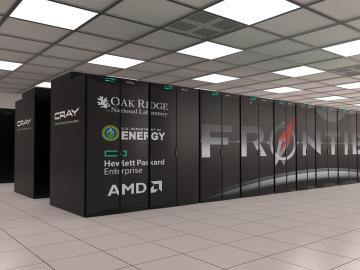
Filter News
Area of Research
- (-) Biology and Environment (52)
- (-) Supercomputing (39)
- Advanced Manufacturing (2)
- Biology and Soft Matter (1)
- Building Technologies (2)
- Clean Energy (49)
- Computational Biology (1)
- Computer Science (1)
- Electricity and Smart Grid (1)
- Functional Materials for Energy (2)
- Fusion and Fission (15)
- Isotopes (3)
- Materials (43)
- Materials for Computing (6)
- National Security (25)
- Neutron Science (14)
- Renewable Energy (1)
News Topics
- 3-D Printing/Advanced Manufacturing (3)
- Advanced Reactors (1)
- Artificial Intelligence (9)
- Big Data (4)
- Bioenergy (15)
- Biology (27)
- Biomedical (5)
- Biotechnology (3)
- Buildings (4)
- Chemical Sciences (7)
- Clean Water (2)
- Climate Change (18)
- Composites (2)
- Computer Science (12)
- Coronavirus (4)
- Critical Materials (2)
- Cybersecurity (2)
- Decarbonization (9)
- Energy Storage (5)
- Environment (26)
- Exascale Computing (7)
- Frontier (7)
- Grid (3)
- High-Performance Computing (11)
- Hydropower (5)
- Machine Learning (7)
- Materials (11)
- Materials Science (7)
- Mercury (1)
- Microscopy (7)
- Nanotechnology (5)
- National Security (3)
- Net Zero (1)
- Neutron Science (2)
- Nuclear Energy (1)
- Partnerships (3)
- Physics (1)
- Polymers (1)
- Quantum Computing (7)
- Quantum Science (4)
- Security (2)
- Simulation (5)
- Space Exploration (1)
- Summit (7)
- Sustainable Energy (10)
- Transformational Challenge Reactor (1)
- Transportation (1)
Media Contacts

Computational users at the Oak Ridge Leadership Computing Facility, or OLCF, are running scientific codes on Frontier’s architecture in the form of a powerful test system at the OLCF called Crusher.

A study by researchers at the ORNL takes a fresh look at what could become the first step toward a new generation of solar batteries.

Bryan Piatkowski, a Liane Russell Distinguished Fellow in the Biosciences Division at ORNL, is exploring the genetic pathways for traits such as stress tolerance in several plant species important for carbon sequestration

A team of researchers working within the Center for Bioenergy Innovation at ORNL has discovered a pathway to encourage a type of lignin formation in plants that could make the processing of crops grown for products such as sustainable jet fuels easier and less costly.

Scientists’ increasing mastery of quantum mechanics is heralding a new age of innovation. Technologies that harness the power of nature’s most minute scale show enormous potential across the scientific spectrum

Surrounded by the mountains of landlocked Tennessee, Oak Ridge National Laboratory’s Teri O’Meara is focused on understanding the future of the vitally important ecosystems lining the nation’s coasts.

Every day, hundreds of thousands of commuters across the country travel from houses, apartments and other residential spaces to commercial buildings — from offices and schools to gyms and grocery stores.

University of Pennsylvania researchers called on computational systems biology expertise at Oak Ridge National Laboratory to analyze large datasets of single-cell RNA sequencing from skin samples afflicted with atopic dermatitis.

A team of scientists from LanzaTech, Northwestern University and ORNL have developed carbon capture technology that harnesses emissions from industrial processes to produce acetone and isopropanol

A study led by researchers at ORNL used the nation’s fastest supercomputer to close in on the answer to a central question of modern physics that could help conduct development of the next generation of energy technologies.


